In Defense of the Quilombo Boca Do Rio

BRAZIL – We are the Traditional Community of Quilombo Boca Do Rio, our territory is located in Baia de Aratu, municipality of Candeias, state of Bahia. We are duly recognized as Quilombolas by the Brazilian State, certified by Fundação Cultural Palmares. In the 1930s and 1940s, the Brazilian Navy began to covet our territory to build a military base, the Aratu Naval Base, creating conflicts with our ancestors. These confrontations culminated in a settlement between the Navy and the heirs of the slaveowner Wanderley Pinho, who registered a public deed and officially recognized our property over a fraction of the territory to facilitate the installation of petrochemical companies in our traditional territory. The violence is so intense that Braskem S/A, a company of the Odebrecht Group, is releasing chemical products onto our community to compel our people to abandon their homes. We are experiencing a real chemical war! In September of 2020, we were surprised by the start of construction work on a private port owned by the company BAHIA TERMINAIS S/A. The construction started with the devastation of the Atlantic Forest, mangroves, removing of hills, landfill of the sea, destruction of rivers and water sources. In view of the seriousness of the violations that we report here, we call on all organizations to give as much publicity as possible and, at the same time, to pressure Brazilian authorities to take appropriate measures to guarantee our rights! We ask you to contact the following authorities. READ MORE GLOBAL Underfunded nature-based solutions could offer big climate benefits

GLOBAL – Nature-based solutions are key to advancing climate adaptation. These are approaches that work with nature, not against it — from restoring wetlands, which can protect against storms, to conserving forests that stabilize soil and runoff during floods. Mangrove forests, for example, save an estimated $80 billion per year in avoided losses from coastal flooding globally, and protect up to 18 million people. Additionally, nature-based solutions can provide many co-benefits — for nature, economies, communities, culture and health. But despite these extensive benefits, new research finds that as little as 1.5 percent of all public international climate finance has gone to support nature-based solutions for adaptation in developing countries. Just a handful of major bilateral donors and multilateral institutions have driven public funding for these approaches. The first assessment of global funding for nature-based solutions for adaptation, produced by WRI and Climate Finance Advisors — in support of the Global Commission on Adaptation’s Nature-based Solutions Action Track — finds that while there is increasing awareness and interest of natural solutions for adaptation, this has not yet translated into adequate financial support for developing countries. READ MORE AFRICA Mangrove Ecosystem in Mesurado Wetlands Under Enormous Threat
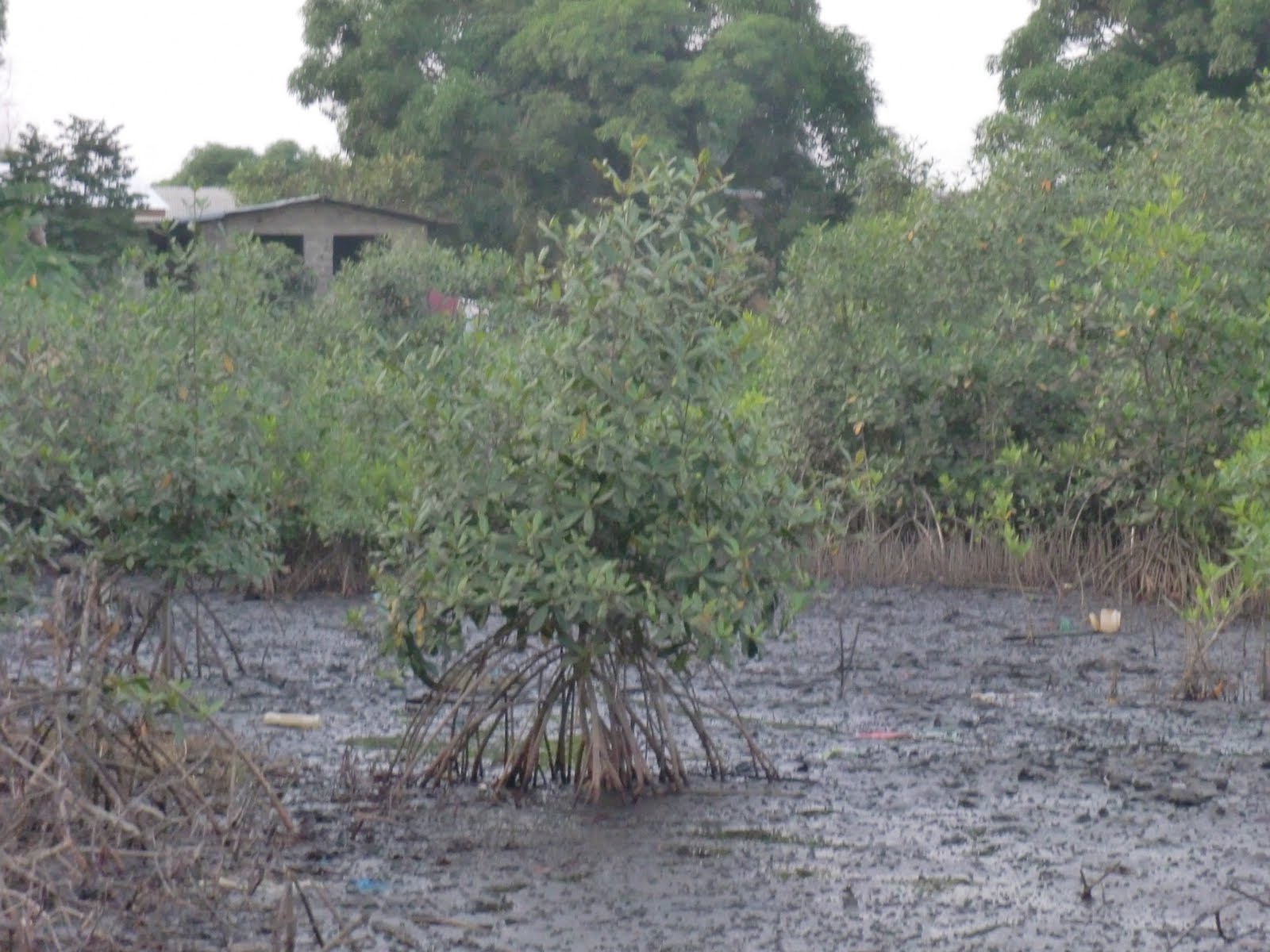
LIBERIA – Located at the back of the massive inter-ministerial complex, in Congo town, Peace Island- a beautiful piece of settlement has in the last decade seen its population surge to unbelievable levels. Once a reserved government land, it is believed to have been occupied by mostly northerners who may have come to Monrovia fleeing conflict and violence resulting from the years of war. But the beauty of the uphill island- the lining of mangrove swamp was come under threat of destruction as over population and lack of sustainable livelihood for dwellers has resulted to visible destruction of the natural environment in a next-door Monrovia settlement. Unprecedented encroachments, colossal waste dumps, and, in cases, enormous cutting of mangrove trees for fish drying can be seen with just a walk around what could be a beautify site for tourism. The EPA says it is doing all to stop the destruction of mangrove here, but its efforts could be too small to curb what a pro- environment youth movement describes as “fast destruction of nature” right before the eyes of authorities. Youth Climate Change Initiative- (YCCI-Liberia) Liberia, a climate and environment non-for-profit recently moved into Peace Island with a team of environment and climate professionals for a dialogue on the need to preserve mangrove swamps. READ MORE AMERICAS Unchecked development poses threats to Cayman
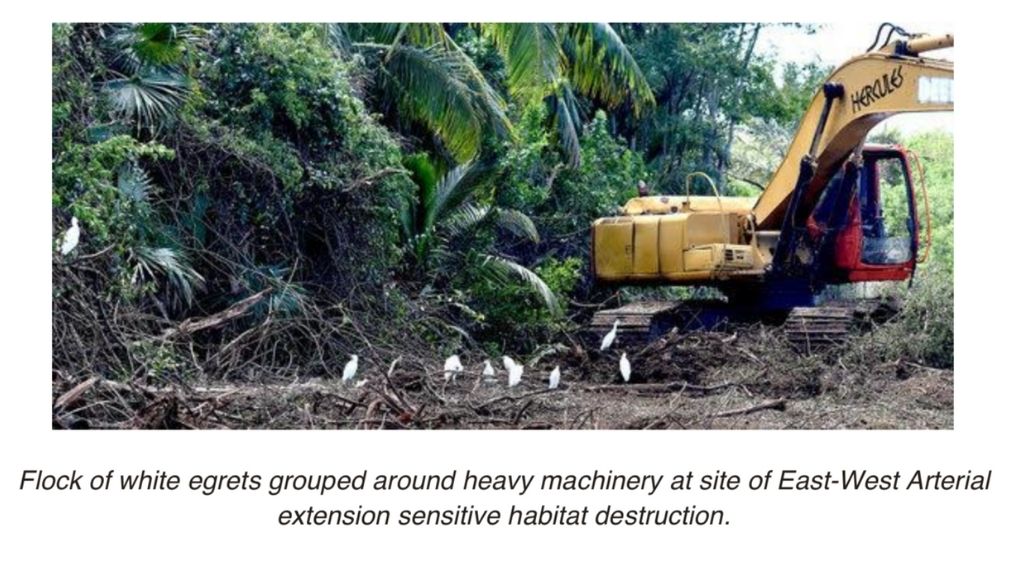
CAYMAN ISLANDS – As a rash of roads and luxury building projects push forward in the lead up to the April 14 elections, The Cayman Islands Mangrove Rangers have begun reaching out to the construction sector, including Dart, to invite discussion on environmentally conscious development. With the Plan Cayman development scheme underway, Grand Cayman faces extensive loss of its already devastated wetlands. The same roads and building projects that buoy the pandemic-stricken economy come with long-term environmental threats when planning regulations and best practices are not enforced. Between 1976 and 2018, 72 per cent of the mangrove habitat in western Grand Cayman, spanning from Savannah to West Bay, had already been lost, according to data shared by the Department of Environment. That’s 3,845 acres of natural hurricane protection and native habitat gone, and the number grows by the day. As part of government’s development plans, more than $30 million worth of roads projects have been given the green light. Much of the two-mile expansion of the East-West Arterial had already been cleared on 6 March when rangers Dinara Perera and Kayla Young visited the site. READ MORE ‘50,000 bags of fertilizer:’ What could Piney Point do to Tampa Bay?

USA – The focus for emergency teams at the old Piney Point phosphate plant property is stopping a flood from surging out of an enormous, leaking reservoir of polluted water. Success on that front could mean pumping a majority of the 480 million gallons of wastewater into Tampa Bay, posing an ecological danger to the treasured estuary that clean water advocates say may endure for weeks or months. Recent releases had dropped the pond level by approximately 100 million gallons. “That’s like dumping 50,000 bags of fertilizer into the bay all at once,” said Ed Sherwood, director of the Tampa Bay Estuary Program. The Estuary Program has tracked the nitrogen load, mostly from runoff, in that portion of the bay from Port Manatee to Pinellas Point and south for years. The releases to the port, if they continue until the pond is empty, could in a matter of days put in “double the amount of nutrients … than what we would like to see in an entire year,” Sherwood said. READ MORE Environmental restoration at home: Sanibel volunteers grow mangroves
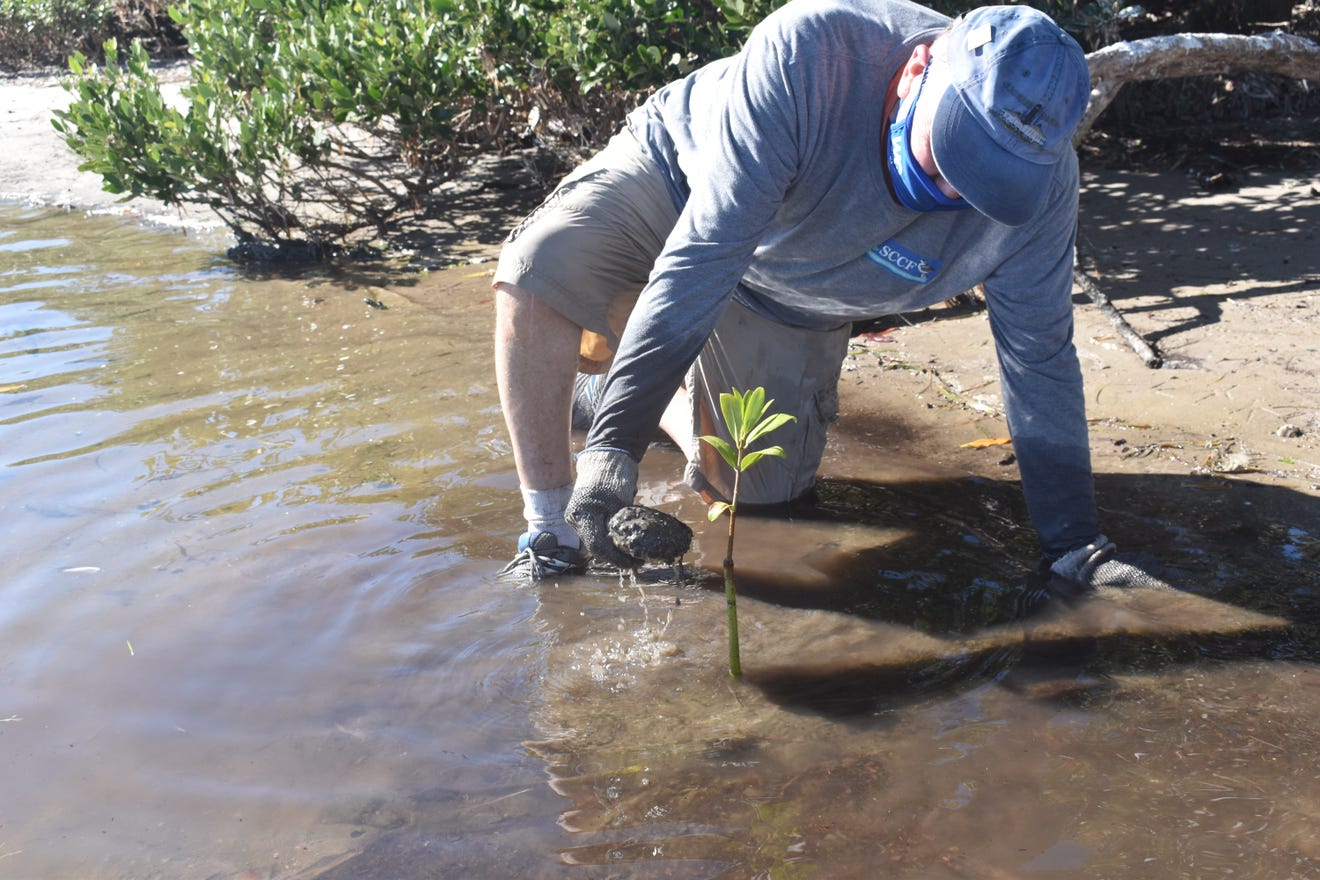
USA – Sitting in various corners and countertops in Sanibel homes, 140 young red mangroves soak up sunshine, waiting to be planted. Volunteers caring for the plants learned about the important role mangroves play in Florida during recent online workshops. From protecting shorelines against storms to creating a nursery for a plethora of sea life, mangrove habitat is a vital resource. The “walking trees” as they’re sometimes called, are part of Coastal Watch’s Back to our Roots initiative under the Sanibel-Captiva Conservation Foundation’s educational arm — Sanibel Sea School. Kealy McNeal, the conservation initiative coordinator at the Sanibel Sea School, said the program was a way to get the community involved. “Really, the biggest part of this is the education component of the initiative,” McNeal said. “Not only are we having the volunteers grow mangroves but we’re also having them understand why they are growing them: how animals rely on them, how they reduce erosion, manage water quality and create a buffer against storm damage.” READ MORE ASIA With stories and puppets, environmentalist battles to save Indonesia’s mangroves

INDONESIA – Caked in mud up to their knees, a small group of Indonesian youngsters plant mangrove saplings along a stretch of exposed coastline next to the Java Sea under the watchful eye of local environmentalist Samsudin. A former school teacher, Samsudin has now dedicated his life to conservation and uses puppetry and storytelling to spread his message to the young about the importance of protecting mangroves in an area suffering massive coastal erosion. “To keep tides from hitting us, we plant mangroves, forests for animals and oxygen for us to live. I weave everything into my stories,” said Samsudin, 50, as he mused how some people in the area saw mangroves as a “nuisance” and would pull them out. Indonesia is home to over a fifth of the world’s mangrove forests, which naturally help keep out high tidal waters. But for years, coastal communities have chopped down trees to clear the way for fish and shrimp farms, and for rice paddies. READ MORE World’s Largest Mangrove Forest Reels from Aggressive Development
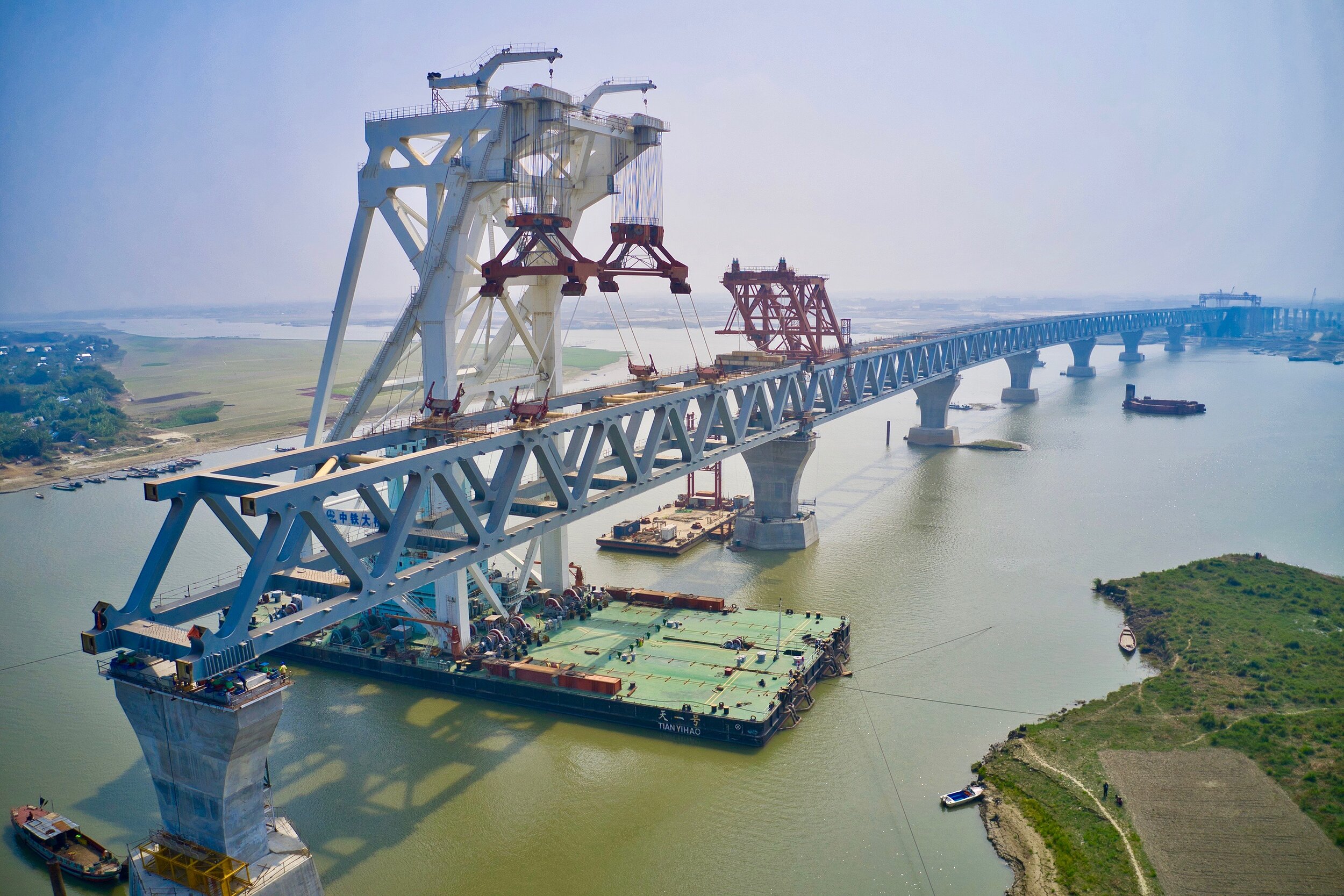
BANGLADESH – The world’s largest mangrove forest — the Sundarbans, which occur in Bangladesh and neighbouring India — is being imperiled by major development projects in addition to the rapidly changing climate and sea level rise. With its impending completion, Padma Bridge, one of the most challenging construction projects in Bangladesh’s history, will open up prospects for the local economy. Costing around US $6.2 billion, the 6.2 km-long bridge is expected to boost Bangladesh’s GDP by as much as 1.2 percent. But there is a downside — a big one. The Padma Bridge may destroy the Sundarbans, if unplanned development in southwestern Bangladesh follows the opening of the bridge, as has often occurred elsewhere with such projects. There is no other place like the Sundarbans on Earth. Bangladesh is already considered a leader in climate-change adaptation and could also be in the vanguard for climate and biodiversity goals, making major commitments under the Paris climate accords and the Convention on Biological Diversity. But the future of Bangladesh’s critical ecosystems and wildlife is far from certain. The pending completion of the long-awaited Padma Bridge is providing both an opportunity and a challenge for the Bangladesh government to demonstrate its commitment to green development and environmental leadership. As its mega-bridge proceeds, the world is keenly watching Bangladesh. READ MORE Japan’s Sumitomo Corp is still pushing dirty coal

BANGLADESH – In the wake of the fiercest storm Bangladesh has experienced this century, Japanese financial institutions and coal developers are trying to push three new coal power stations, fuelling extreme weather and climate change. Locals on remote Matarbari Island on the southeastern coast of Bangladesh are still dealing with the devastation of super cyclone Amphan, which has displaced over two million people. But these communities are also contending with a massive build-out of coal power which threatens their lives and livelihoods, and will worsen the extreme weather conditions caused by climate change. Sumitomo Corporation (Sumitomo), the Japan International Cooperation Agency (JICA), Sumitomo Mitsui Banking Corporation (SMBC) and Nippon Export and Investment Insurance (NEXI) are pursuing proposed new coal power stations totalling 3,100 MW of capacity. These projects have: displaced local communities, destroyed livelihoods, and violated workers’ rights, would worsen air pollution, killing thousands of people over the lifetime of the projects, would increase climate impacts on the already vulnerable Bangladesh, releasing millions of tonnes of CO2 throughout the plants’ operational lifetimes, and violate the climate policies of JICA, SMBC and Sumitomo. Given these health, human rights and climate impacts, Sumitomo, JICA, NEXI and SMBC need to get out of the coal projects on Matarbari Island immediately. TAKE ACTION! Java’s mangroves pay a high price for stopping plastic flowing out to sea

INDONESIA – Celine van Bijsterveldt and her team had traveled to Central Java’s mangrove forests to investigate efforts to restore them. But when the researchers saw plastic trash strewn throughout the swamps, ensnaring roots and shrouding branches, they were instead compelled to examine its toll on the trees. “It’s a crazy amount of plastic,” said van Bijsterveldt, a doctoral candidate at Utrecht University and NIOZ Royal Netherlands Institute for Sea Research, and the lead author of the resulting paper in Science of The Total Environment. “You just couldn’t ignore it.” Although mangroves adapt to plastic debris, too much can kill them. Scientists worry that its continued accumulation could endanger these forests and the ecological and human communities depending on them. This concern is especially pressing in Indonesia, home to almost one-quarter of the world’s mangrove ecosystems and to highly acute plastic litter and mangrove destruction. READ MORE Like this newsletter?
Pease consider donating to MAP to keep it going.
Giving could never be easier  | URGENT ACTION Stop construction work on a private port In Defense of the Quilombo Boca Do Rio TAKE ACTION! Tell Sumitomo to stop building polluting coal power in Bangladesh! TAKE ACTION! Stop Adaro, Indonesia’s coal giant, from refinance its debt.
TAKE ACTION Buy a Pin – Support MAP
 2021
CHILDREN’S ART CALENDAR BUY YOURS!
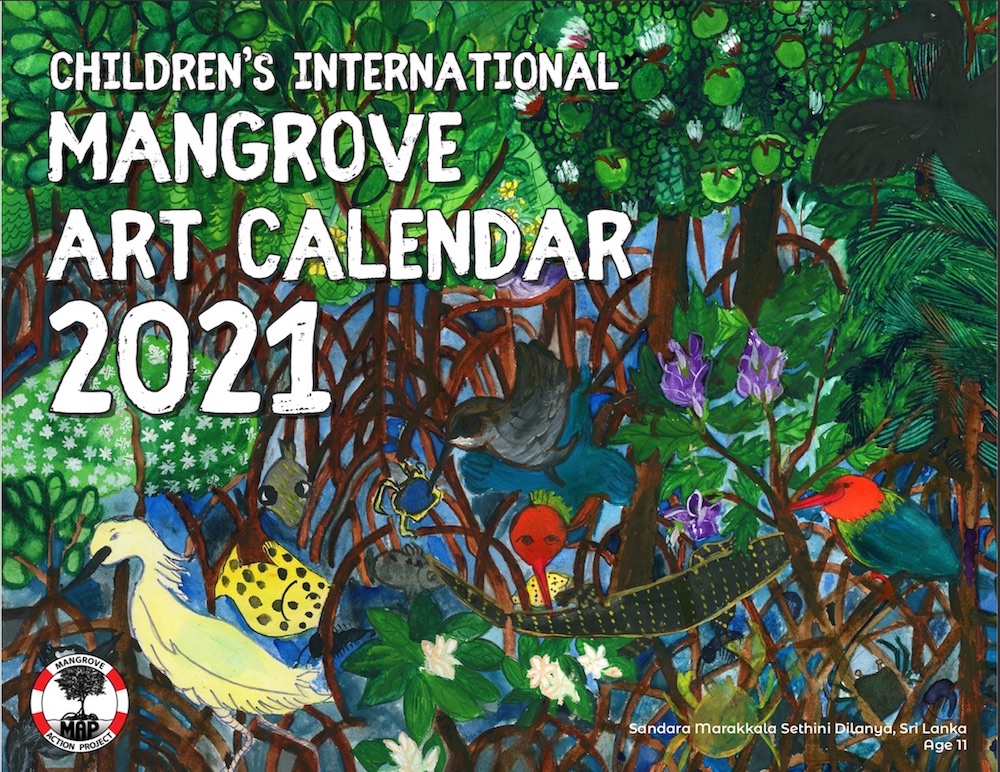
ACTION ALERTS Lawsuit Against Genetically Engineered Tree Solidarity Group – SIGN PETITION Tell the Japan International Cooperation Agency not to fund polluting coal – TAKE ACTION Please SIGN: keep plantations out of orangutan habitat!
TAKE ACTIONUnilever: stop destroying mangroves for convenience food! SIGN OUR PETITION
Stop plundering the oceans for industrial aquaculture! SIGN THE PETITION
Like this newsletter? Pease consider donating to MAP to keep it going. Giving could never be easier
Please see our newest video: “Restoring The Natural Mangrove Forest”
WATCH VIDEO 
Restoring The Natural Mangrove Forest
Watch movie 
Community Based Ecological Mangrove Restoration in Rufiji Delta VIEW VIDEO Video: Mangroves for the Future – A look bacK. As the latest phase of Mangroves for the Future (MFF) draws to a close, this video highlights some of the project’s most successful initiatives – from local women supporting national park management in Viet Nam to an island in the Maldives that has become a model for waste management, and everything in between. View Here WANT TO GET INVOLVED?
Follow and Join MAP!    
Like this newsletter? Pease consider donating to MAP to keep it going. Giving could never be easier 

Singing for the Sundarbans WATCH HERE Entrevista con Monica Quarto del Mangrove Action Project (Spanish language) Oye Aqui
VOLUNTEER OPPORTUNITY 
MANGROVE ISSUES Want to learn more about mangroves?
Our short presentation will give you a better understanding of the issues we are working to solve. WATCH PRESENTATION What is CBEMR? Download MAP’s 2 page CBEMR Information Sheet containing links to all MAP’s CBEMR resources – CLICK HERE
View MAP’s uploaded Videos at
MAP Video Gallery Question Your Shrimp Consumer/Markets Campaign!
WATCH VIDEO Mangroves: Guidebook to Malaysia – Click Here SHARE MAP’S VISION
CLICK HERE to watch short introductory video. Together we can work “at the roots of the sea”. Our short documentary, Reducing the Risk of Disaster through Nature-Based Solutions : Mangroves

Marvellous Mangroves Curriculum The Marvellous Mangroves Curriculum begins with a simple philosophy – getting future generations to not only learn about, but understand the importance of mangrove forests. VISIT 
The award-winning Marvellous Mangroves (MM) curriculum educates children on the importance of mangroves and their ecological functions, teaching them about modern challenges and mechanisms for sustainability. VIEW VIDEO Marvellous Mangroves Curriculum in Bangladesh – WATCH VIDEO
MARVELLOUS MANGROVES IN BRAZIL
En Portuges 
Marvellous Mangroves – A Curriculum-Based Teachers Guide.
Like this newsletter? Pease consider donating to MAP to keep it going. Giving could never be easier 
“Question Your Shrimp” Campaign Question Your Shrimp – is it really sustainable? Sign the Petition
Note to Our Readers: We strive to keep active links in our newsletter. However, due to circumstances beyond our control, occasionally links to stories may become broken. If you find a link to a story is not functioning, please cut and paste the headline into your browser search bar. In most cases you should be able to locate the original story.
Not yet a MAP News subscriber?
Click here to subscribe. 
|

























